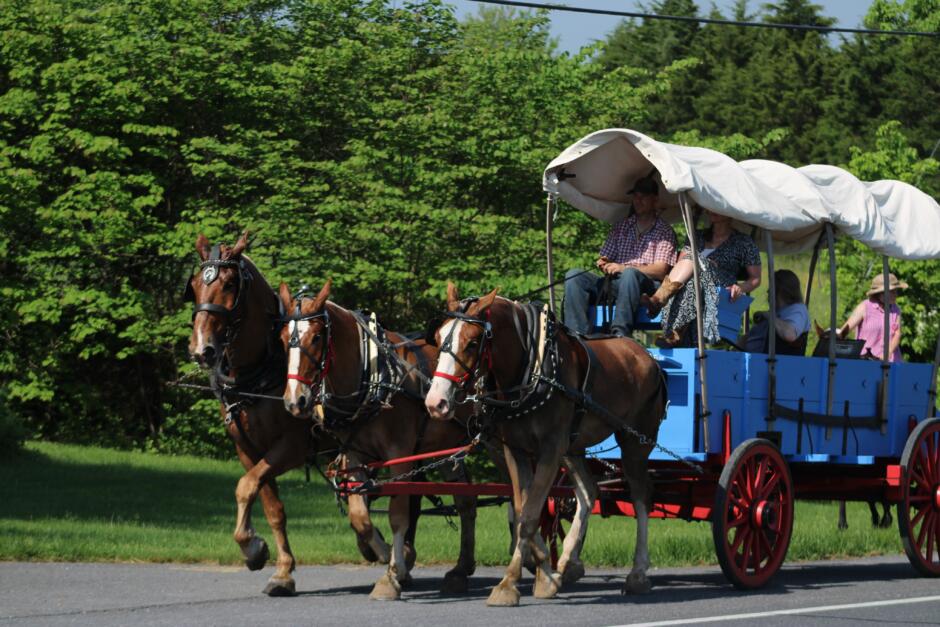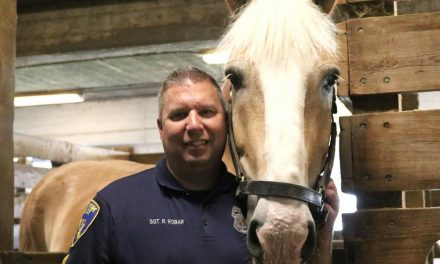by the MHC Membership Committee with photos by photos by © Zachary M Sipe 2022 (first published in the July 2022 Equiery)
The National Pike Festival and James Shaull Wagon Train is a step back in time. The festival takes place in Washington County the weekend before Memorial Day, starting on a Friday evening in Clear Spring and over two days, travels 32-miles in a wagon-train journey to Boonsboro. “Travel the Road that Made the Nation” Wagon trains have been rolling since 1989 as a part of the Washington County segment of the National Pike Festival. Located between the Allegheny Mountains and the Blue Ridge Mountains, Washington County played a key role in opening the West to the nation.
In 1797, Baltimore bankers and businessmen were instrumental in extending the Baltimore-National Pike, also known in Washington County as the Bank Road, to Cumberland. This roadway became part of the National Road. In 1806, President Thomas Jefferson signed into law an act authorizing federal funds to build a westward road starting in Cumberland, Maryland. Construction began in 1811, and by 1838, had reached Vandalia, Illinois, covering a distance of about 620 miles. The National Road was the first road built by the federal government, setting the stage for federal support of our modern transportation system. Many counties in Maryland, West Virginia, Pennsylvania, and Ohio celebrate this 300-mile route with authentic wagon train re-enactments and other period activities.
The National Pike Festival and James Shaull Wagon Train is organized by the James Shaull Wagon Train Foundation, Inc. The Foundation was formed in 2000 in honor of James Shaull. “Jimmy,” who farmed with his Belgian horses, started the Washington County segment of the National Pike Festival, and was the Wagon Master for the National Pike Festival in 2000, prior to his death in a farming accident. Passersby would often stop on Sharpsburg Pike in Boonsboro to watch him plow his fields with his four abreast Belgian horse-hitch.
The Foundation’s mission is to educate the public by continuing the tradition of the National Pike Festival Wagon Train which retraces the route of the Old National Road that helped open the West. The Foundation awards scholarships from the proceeds of the Wagon Train to high school students, preferably from Washington County Public Schools, who seek to further their education in Agriculture, Agronomy, Bio-Chemistry, Chemistry, Horticulture, or other related fields. Applicants must have a 3.0 GPA and apply for the scholarship by submitting a statement of interest which describes their career goals.
This year, the Festival offered an opening night of festivities, including The Warp Rock Band, and an encampment at the Clear Spring Volunteer Fire Company Bingo Hall. The Wagon Train headed out Saturday morning to the R.H. Wilson General Store in Clear Spring, which was one of many historic establishments along the National Road. Rufus Wilson built the general store near the banks of Maryland’s Conococheague Creek in 1847. The store attracted drovers, farmers, and travelers. Eventually, bypassed by a railroad and modern highways, business dwindled, and the store closed its doors in 1975. Today, the R.H. Wilson and Son General Store has been carefully restored. Purchased in 1983 by Lewis and Frances Horst, this historic landmark appears as a page right out of the 19th century. The store features a selection of cheeses and meats, period toys, old fashioned candies, glass bottled soda, old-time remedies, heirloom seeds and antiques.
Another stop on the Wagon Train is the historic Hagerstown City Park, which features the Jonathan Hager House & Museum, the original homestead of Hagerstown’s founder Jonathan Hager. The City Park offers man-made lakes, wooded walking trails, picnic facilities, and active recreation facilities. It is also home to the Washington County Museum of Fine Arts, the Hagerstown Railroad Museum and Engine 202, and the Mansion House Art Center.
The Wagon Train’s Saturday night encampment was at the Funkstown Community Park. Jacob Funck planned a village named “Jerusalem” in 1767. Early residents referred to the town as “Funck’s Jerusalem Town’”, which became part of Washington County in 1776, and was incorporated as “Funkstown” in 1840. In 1823 the Old National Pike was built through “Funck’s Town” and the first of two stone arch bridges was constructed over the Antietam Creek by James Lloyd to allow traffic on the Old National Pike to pass over the creek on its way toward the Allegheny Mountains.
The Wagon Train’s final stop was Shafer Park in Boonsboro. Boonsboro was founded in 1792 by two brothers, George and William Boone, cousins of Daniel Boone. Boonsboro had a sleepy start. In 1803, 11 years after the town was established, there were only 24 houses. Boonsboro’s growth and prosperity got a boost in part by the construction of the National Road. In 1823, a new process called “macadam” was used to finish an unpaved section of the turnpike from Boonsboro to Hagerstown. This was the first time this road building process was used in the United States.
Additional stops on the Wagon Train’s itinerary include Huyett’s Crossroads and the Wacohu Grange, and Ravenwood Lutheran Village. Visiting the wagon train along the route is encouraged and is open to the public and free. The 2023 dates are May 19-21. For more information visit www.nationalpikefestival.org, or follow the National Pike Festival and James Shaull Wagon Train on Facebook.













